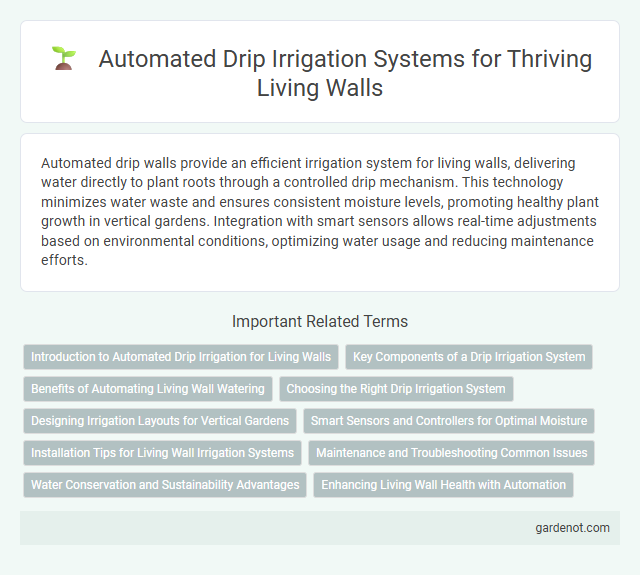Automated drip walls provide an efficient irrigation system for living walls, delivering water directly to plant roots through a controlled drip mechanism. This technology minimizes water waste and ensures consistent moisture levels, promoting healthy plant growth in vertical gardens. Integration with smart sensors allows real-time adjustments based on environmental conditions, optimizing water usage and reducing maintenance efforts.
Introduction to Automated Drip Irrigation for Living Walls
Automated drip irrigation systems for living walls deliver precise water amounts directly to plant roots, enhancing water efficiency and plant health. These systems use timers and sensors to regulate water flow, reducing waste and ensuring consistent moisture levels. Integration with smart technology allows for remote monitoring and adjustments, optimizing the growth environment for vertical gardens.
Key Components of a Drip Irrigation System
Key components of an automated drip wall irrigation system include drip emitters, which regulate water flow directly to plant roots, ensuring efficient moisture delivery and reduced water wastage. Pressure regulators maintain optimal water pressure for consistent drip rates, while filters prevent clogs by trapping debris and particulates. A timer or controller automates watering schedules to optimize hydration cycles, enhancing plant health and system efficiency.
Benefits of Automating Living Wall Watering
Automated drip watering systems for living walls ensure consistent moisture levels, promoting healthier plant growth and reducing water waste by delivering precise amounts directly to the roots. This technology lowers maintenance efforts and costs by minimizing manual watering, preventing overwatering and root rot. Enhanced water efficiency and optimized plant health contribute to sustainable urban greenery and improved air quality.
Choosing the Right Drip Irrigation System
Selecting the right automated drip irrigation system for a living wall involves evaluating water flow rates, emitter spacing, and pressure regulation to ensure uniform moisture distribution. Consider systems with adjustable emitters and timers to customize watering schedules based on plant species and environmental conditions. High-quality components resistant to clogging and corrosion enhance system durability and reduce maintenance needs.
Designing Irrigation Layouts for Vertical Gardens
Automated drip wall systems optimize water distribution in vertical gardens by precisely controlling irrigation schedules and flow rates to meet the specific needs of each plant species. Designing irrigation layouts involves mapping plant types, root depth, and sun exposure to ensure balanced moisture levels and prevent water waste. Integration of sensors and smart controllers allows real-time monitoring and adjustment, enhancing plant health and system efficiency in living walls.
Smart Sensors and Controllers for Optimal Moisture
Automated drip wall systems utilize smart sensors and controllers to maintain optimal moisture levels, ensuring precise water delivery tailored to plant requirements. These sensors monitor soil moisture and environmental conditions in real-time, allowing controllers to adjust irrigation schedules automatically for efficient water use. Integrating IoT technology enhances plant health and reduces water waste by preventing over- or under-watering in living wall installations.
Installation Tips for Living Wall Irrigation Systems
Automated drip wall irrigation systems require precise placement of drip emitters near plant roots to ensure consistent moisture delivery and reduce water waste. Use pressure-compensating emitters to maintain uniform water flow across the vertical surface, preventing overwatering or dry spots. Secure tubing with clips or adhesive mounts to avoid sagging or displacement, ensuring reliable operation in a living wall setup.
Maintenance and Troubleshooting Common Issues
Automated drip walls require regular inspection to ensure emitters are not clogged with debris or mineral buildup, which can reduce water flow and plant health. Routine flushing of the system and checking pressure levels prevent blockages and maintain efficient water distribution. Troubleshooting common issues involves verifying timer settings, inspecting tubing for leaks, and replacing damaged emitters to sustain optimal irrigation performance.
Water Conservation and Sustainability Advantages
Automated drip walls optimize water usage by delivering precise amounts of water directly to plant roots, drastically reducing runoff and evaporation. This targeted irrigation system supports sustainability by lowering overall water consumption and minimizing waste compared to traditional watering methods. Integration of sensors and timers allows for real-time adjustments based on soil moisture and weather conditions, enhancing efficiency and promoting long-term environmental conservation.
Enhancing Living Wall Health with Automation
Automated drip wall systems optimize water distribution by delivering precise moisture levels tailored to each plant's needs, significantly improving living wall health. Sensors monitor soil moisture and environmental conditions, enabling real-time adjustments that prevent overwatering and promote root vitality. This technology extends plant longevity, reduces maintenance efforts, and supports sustainable green wall ecosystems.
Automated drip wall Infographic

 gardenot.com
gardenot.com